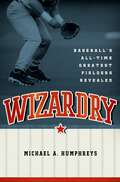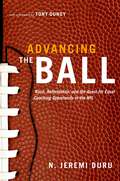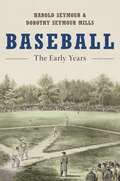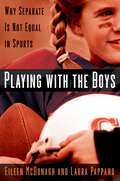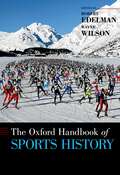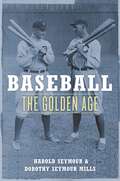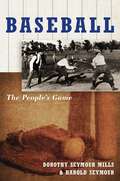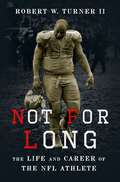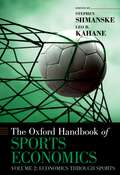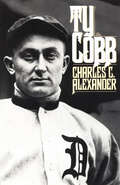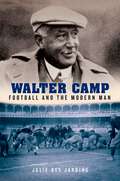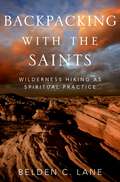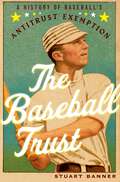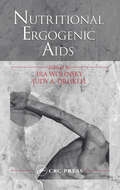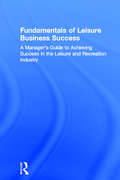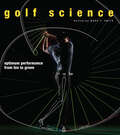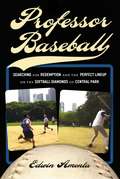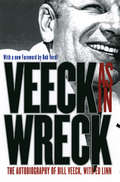- Table View
- List View
Wizardry: Baseball's All-Time Greatest Fielders Revealed
by Michael HumphreysThe systematic analysis of baseball statistics, often called "sabermetrics," has evolved in recent years to resemble something of a science, attracting fans from diverse professional and educational backgrounds, all fascinated by the analysis itself and its insights into the game. But one problem has defied solution: estimating runs saved by fielders throughout history. Traditional statistics include errors and plays made, but not hits that could or should have been prevented. The latter can now be estimated using records of the location of every batted ball, but the underlying data exists only for recent seasons and has generally been withheld from the public. Now, in Wizardry, comes the long-awaited breakthrough. Drawing solely on freely available baseball statistics, Michael A. Humphreys shows how to apply classic statistical methods to estimate runs saved by fielders going back to 1893. Humphreys tests his results against other fielding measures, including published ratings based on proprietary batted ball location data, and explains their respective strengths and limitations. He also introduces a method for adjusting historical player ratings for increased competition due to population growth, integration, and international recruitment. Position by position, Humphreys identifies and profiles the greatest fielders of all time with anecdote-rich essays. Sabermetrics changed baseball and introduced a generation to the art of statistical inference. Wizardry makes the case for the most significant changes in historical player valuation in decades, while opening up new approaches for further exploration.
Advancing the Ball: Race, Reformation, and the Quest for Equal Coaching Opportunity in the NFL (Law and Current Events Masters)
by N. Jeremi DuruFollowing the NFL's desegregation in 1946, opportunities became increasingly plentiful for African American players--but not African American coaches. Although Major League Baseball and the NBA made progress in this regard over the years, the NFL's head coaches were almost exclusively white up until the mid-1990s. Advancing the Ball chronicles the campaign of former Cleveland Browns offensive lineman John Wooten to right this wrong and undo decades of discriminatory head coach hiring practices--an initiative that finally bore fruit when he joined forces with attorneys Cyrus Mehri and Johnnie Cochran. Together with a few allies, the triumvirate galvanized the NFL's African American assistant coaches to stand together for equal opportunity and convinced the league to enact the "Rooney Rule," which stipulates that every team must interview at least one minority candidate when searching for a new head coach. In doing so, they spurred a movement that would substantially impact the NFL and, potentially, the nation. Featuring an impassioned foreword by Coach Tony Dungy, Advancing the Ball offers an eye-opening, first-hand look at how a few committed individuals initiated a sea change in America's most popular sport and added an extraordinary new chapter to the civil rights story.
Wizardry: Baseball's All-Time Greatest Fielders Revealed
by Michael HumphreysThe systematic analysis of baseball statistics, often called "sabermetrics," has evolved in recent years to resemble something of a science, attracting fans from diverse professional and educational backgrounds, all fascinated by the analysis itself and its insights into the game. But one problem has defied solution: estimating runs saved by fielders throughout history. Traditional statistics include errors and plays made, but not hits that could or should have been prevented. The latter can now be estimated using records of the location of every batted ball, but the underlying data exists only for recent seasons and has generally been withheld from the public. Now, in Wizardry, comes the long-awaited breakthrough. Drawing solely on freely available baseball statistics, Michael A. Humphreys shows how to apply classic statistical methods to estimate runs saved by fielders going back to 1893. Humphreys tests his results against other fielding measures, including published ratings based on proprietary batted ball location data, and explains their respective strengths and limitations. He also introduces a method for adjusting historical player ratings for increased competition due to population growth, integration, and international recruitment. Position by position, Humphreys identifies and profiles the greatest fielders of all time with anecdote-rich essays. Sabermetrics changed baseball and introduced a generation to the art of statistical inference. Wizardry makes the case for the most significant changes in historical player valuation in decades, while opening up new approaches for further exploration.
Baseball: The Early Years
by Harold Seymour Dorothy Seymour MillsNow available in paperback, Harold Seymour and Dorothy Seymour Mills' Baseball: The Early Years recounts the true story of how baseball came into being and how it developed into a highly organized business and social institution. The Early Years, traces the growth of baseball from the time of the first recorded ball game at Valley Forge during the revolution until the formation of the two present-day major leagues in 1903. By investigating previously unknown sources, the book uncovers the real story of how baseball evolved from a gentleman's amateur sport of "well-bred play followed by well-laden banquet tables" into a professional sport where big leagues operate under their own laws. Offering countless anecdotes and a wealth of new information, the authors explode many cherished myths, including the one which claims that Abner Doubleday "invented" baseball in 1839. They describe the influence of baseball on American business, manners, morals, social institutions, and even show business, as well as depicting the types of men who became the first professional ball players, club owners, and managers, including Spalding, McGraw, Comiskey, and Connie Mack. Note: On August 2, 2010, Oxford University Press made public that it would credit Dorothy Seymour Mills as co-author of the three baseball histories previously "authored" solely by her late husband, Harold Seymour. The Seymours collaborated on Baseball: The Early Years (1960), Baseball: The Golden Age (1971) and Baseball: The People's Game (1991).
Playing With the Boys: Why Separate is Not Equal in Sports
by Eileen McDonagh Laura PappanoAthletic contests help define what we mean in America by "success." By keeping women from "playing with the boys" on the false assumption that they are inherently inferior, society relegates them to second-class citizens. In this forcefully argued book, Eileen McDonagh and Laura Pappano show in vivid detail how women have been unfairly excluded from participating in sports on an equal footing with men. Using dozens of powerful examples--girls and women breaking through in football, ice hockey, wrestling, and baseball, to name just a few--the authors show that sex differences are not sufficient to warrant exclusion in most sports, that success entails more than brute strength, and that sex segregation in sports does not simply reflect sex differences, but actively constructs and reinforces stereotypes about sex differences. For instance, women's bodies give them a physiological advantage in endurance sports, yet many Olympic events have shorter races for women than men, thereby camouflaging rather than revealing women's strengths.
The Oxford Handbook of Sports History (Oxford Handbooks)
by Robert Edelman Wayne WilsonOrwell was wrong. Sports are not "war without the shooting", nor are they "war by other means." To be sure sports have generated animosity throughout human history, but they also require rules to which the participants agree to abide before the contest. Among other things, those rules are supposed to limit violence, even death. More than anything else, sports have been a significant part of a historical "civilizing process." They are the opposite of war. As the historical profession has taken its cultural turn over the last few decades, scholars have turned their attention to subject once seen as marginal. As researchers have come to understand the centrality of the human body in human history, they have come to study this most corporeal of human activities. Taking early cues from physical educators and kinesiologists, historians have been exploring sports in all their forms in order to help us answer the most fundamental questions to which scholars have devoted their lives. We have now seen a veritable explosion excellent work on this subject, just as sports have assumed an even greater share of a globalizing world's cultural, political and economic space. Practiced by millions and watched by billions, sports provide an enormous share of content on the Internet. This volume combines the efforts of sports historians with essays by historians whose careers have been devoted to more traditional topics. We want to show how sports have evolved from ancient societies to the world we inhabit today. Our goal is to introduce those from outside this sub-field to this burgeoning body of scholarship. At the same time, we hope here to show those who may want to study sport with rigor and nuance how to embark on a rewarding journey and tackle profound matters that have affected and will affect all of humankind.
Baseball: The Golden Age
by Harold Seymour Dorothy Seymour MillsIn Baseball: The Golden Age, Harold Seymour and Dorothy Seymour Mills explore the glorious era when the game truly captured the American imagination, with such legendary figures as Babe Ruth and Ty Cobb in the spotlight. Beginning with the formation of the two major leagues in 1903, when baseball officially entered its "golden age" of popularity, the authors examine the changes in the organization of professional baseball--from an unwieldy three-man commission to the strong one-man rule of Judge Kenesaw Mountain Landis. They depicts how the play on the field shifted from the low-scoring, pitcher-dominated game of the "dead ball" era before World War I to the higher scoring of the 1920's "lively ball" era, with emphasis on home runs, best exemplified by the exploits of Babe Ruth. Note: On August 2, 2010, Oxford University Press made public that it would credit Dorothy Seymour Mills as co-author of the three baseball histories previously "authored" solely by her late husband, Harold Seymour. The Seymours collaborated on Baseball: The Early Years (1960), Baseball: The Golden Age (1971) and Baseball: The People's Game (1991).
Baseball: The People's Game
by Harold Seymour Dorothy Seymour MillsIn Baseball: The People's Game, Dorothy Seymour Mills and Harold Seymour produce an authoritative, multi-volume chronicle of America's national pastime. The first two volumes of this study -The Early Years and The Golden Age -won universal acclaim. The New York Times wrote that they "will grip every American who has invested part of his youth and dreams in the sport," while The Boston Globe called them "irresistible." Now, in The People's Game, the authors offer the first book devoted entirely to the history of the game outside of the professional leagues, revealing how, from its early beginnings up to World War II, baseball truly became the great American pastime. They explore the bond between baseball and boys through the decades, the game's place in institutions from colleges to prisons to the armed forces, the rise of women's baseball that coincided with nineteenth century feminism, and the struggles of black players and clubs from the later years of slavery up to the Second World War. Whether discussing the birth of softball or the origins of the seventh inning stretch, the Seymours enrich their extensive research with fascinating details and entertaining anecdotes as well as a wealth of baseball experience. The People's Game brings to life the central role of baseball for generations of Americans. Note: On August 2, 2010, Oxford University Press made public that it would credit Dorothy Seymour Mills as co-author of the three baseball histories previously "authored" solely by her late husband, Harold Seymour. The Seymours collaborated on Baseball: The Early Years (1960), Baseball: The Golden Age (1971) and Baseball: The People's Game (1991).
Not for Long: The Life and Career of the NFL Athlete
by Robert W. Turner IIThe NFL is the most popular professional sports league in the United States. Its athletes receive multimillion-dollar contracts and almost endless media attention. The league's most important game, the Super Bowl, is practically a national holiday. Making it to the NFL, however, is not about the promised land of fame and fortune. Robert W. Turner II draws on his personal experience as a former professional football player as well as interviews with more than 140 current and former NFL players to reveal what it means to be an athlete in the NFL and explain why so many players struggle with life after football. Without guaranteed contracts, the majority of players are forced out of the league after a few seasons. Over three-quarters of retirees experience bankruptcy or financial ruin, two-thirds live with chronic pain, and too many find themselves on the wrong side of the law. Robert W. Turner II argues that the fall from grace of so many players is no accident. The NFL, he contends, powerfully determines their experiences in and out of the league. The labor agreement provides little job security and few health and retirement benefits, and the owners refuse to share power with the players, making change difficult. And the process of becoming an elite football player--from high school to college and through the pros--leaves athletes with few marketable skills and little preparation for their first Sunday off the field. With compassion and objectivity, Not for Long reveals the life and mind of high school, college, and NFL athletes, shedding light on what might best help players transition successfully out of the sport.
The Oxford Handbook of Sports Economics: Volume 2: Economics Through Sports (Oxford Handbooks)
Shmanske and Kahane have brought together nearly all of the important authors in the quickly growing field of Sports Economics to contribute chapters to this two-volume set. All of the authors are writing about subjects that they love and subjects that they have devoted years of study to. The result is truly informative in its content and path breaking in its importance to the field. Anyone contemplating research in the field of sports economics will find the works in these volumes to provide both ample background in subject after subject and numerous suggestions for future avenues of research. The editors have recognized two ways that economics and sports interact. First, economic analysis has helped everyone understand many of the peculiar institutions in sports. And second, quality data about individual productivity, salaries, career histories, teamwork, and managerial behavior has helped economists study topics as varied as the economics of discrimination, salary dispersion, and antitrust policy. These two themes of economics helping sports and sports helping economics provide the organizational structure to the two-volume set. The reader will find that sports economists employ or comment on practically every field in economics. Labor Economics comes into play in the areas of salary formation, salary dispersion, and discrimination. Baseball's history and the NCAA are studied with Industrial Organization and Antitrust. Public Finance and Contingent Value Modeling come into play in the study of stadium finance and franchise location. The Efficient Market Hypothesis is examined with data from gambling markets. Macroeconomic effects are studied with data from mega events like the Super Bowl, The World Cup, and the Olympics. The limits of Econometrics are pushed and illustrated with superb data in many of the papers herein. Topics in Applied microeconomics like demand estimation and price discrimination are also covered in several of the included papers. Game Theory, measurement of production functions, and measurement of managerial efficiency all come into play. Talented authors in each of these fields have made contributions to these volumes. The volumes are also rich from the point of view of the sports fan. Every major team sport is covered, and many interesting comparisons can be made especially between the North American League organization and the European-style promotion and relegation leagues. Golf, NASCAR, College athletics, Women's sports, the Olympics, and even bowling are represented in these pages. There is literally something for everyone.
Ty Cobb: Ty Cobb, Napoleon Lajoie, And The Controversial 1910 Batting Title That Became A National Obsession
by Charles C. AlexanderTy Cobb was one of the most famous baseball players who every lived. The author puts Cobb into the context of his times, describing the very different game on the field then, and successfully probes Cobb's complex personality.
Walter Camp: Football and the Modern Man
by Julie Des JardinsAmericans are obsessed with football, yet they know little about the man who shaped the game to make it uniquely technical, physical, and 'man-making' at once. Walter Camp, the "Father of American Football," was the foremost authority on American athletics and arguably the greatest amateur American athlete of his time. In Walter Camp: Football and the Modern Man, Julie Des Jardins chronicles the life of the clock company executive and self-made athlete who remade football and redefined the ideal man. As a student at Yale University, Camp was a varsity letterman who led the earliest efforts to codify the rules and organization of football-including the line of scrimmage and "downs"-to make it distinct from English rugby. He also invented the All-America Football Team and wrote some of the first football fiction, guides, and sports page coverage, making him the foremost popularizer of the game. Within a decade American football was an obsession on college campuses of the Northeast. By the turn of the century, it was a bona fide national pastime. Since the Civil War, college men of good breeding had not a physical skirmish to harden them. They had grown soft, Americans feared, both in body and attitude. Camp saw football as the antidote to the degeneration of these young men. When massive numbers of college football players enlisted to fight in World War I, Camp held them up as proof that football turned men effective and courageous. His influence over the game, however, was not always viewed as beneficial. Under his watch, dozens of college and high school players were killed or maimed on the gridiron. President Theodore Roosevelt urged him to reform football to prevent administrators from banning it, but Camp was ambivalent about removing the very physicality that made the game man-making in his eyes. The criticism targeted at him over the aggressiveness of football still haunts the game today. In this fast-paced biography, Julie Des Jardins shows how the "gentleman athlete" was as much the arbiter of football as he was the arbiter of modern manhood. Though eventually football took on meanings that Camp never intended, his impact on the professional and college game is simply unsurpassed.
Backpacking with the Saints: Wilderness Hiking as Spiritual Practice
by Belden C. LaneCarrying only basic camping equipment and a collection of the world's great spiritual writings, Belden C. Lane embarks on solitary spiritual treks through the Ozarks and across the American Southwest. For companions, he has only such teachers as Rumi, John of the Cross, Hildegard of Bingen, Dag Hammarskjöld, and Thomas Merton, and as he walks, he engages their writings with the natural wonders he encounters--Bell Mountain Wilderness with Søren Kierkegaard, Moonshine Hollow with Thich Nhat Hanh--demonstrating how being alone in the wild opens a rare view onto one's interior landscape, and how the saints' writings reveal the divine in nature. The discipline of backpacking, Lane shows, is a metaphor for a spiritual journey. Just as the wilderness offered revelations to the early Desert Christians, backpacking hones crucial spiritual skills: paying attention, traveling light, practicing silence, and exercising wonder. Lane engages the practice not only with a wide range of spiritual writings--Celtic, Catholic, Protestant, Buddhist, Hindu, and Sufi Muslim--but with the fascination of other lovers of the backcountry, from John Muir and Ed Abbey to Bill Plotkin and Cheryl Strayed. In this intimate and down-to-earth narrative, backpacking is shown to be a spiritual practice that allows the discovery of God amidst the beauty and unexpected terrors of nature. Adoration, Lane suggests, is the most appropriate human response to what we cannot explain, but have nonetheless learned to love. An enchanting narrative for Christians of all denominations, Backpacking with the Saints is an inspiring exploration of how solitude, simplicity, and mindfulness are illuminated and encouraged by the discipline of backcountry wandering, and of how the wilderness itself becomes a way of knowing-an ecology of the soul.
The Baseball Trust: A History of Baseball's Antitrust Exemption
by Stuart BannerThe impact of antitrust law on sports is in the news all the time, especially when there is labor conflict between players and owners, or when a team wants to move to a new city. And if the majority of Americans have only the vaguest sense of what antitrust law is, most know one thing about it-that baseball is exempt. In The Baseball Trust, legal historian Stuart Banner illuminates the series of court rulings that resulted in one of the most curious features of our legal system-baseball's exemption from antitrust law. A serious baseball fan, Banner provides a thoroughly entertaining history of the game as seen through the prism of an extraordinary series of courtroom battles, ranging from 1890 to the present. The book looks at such pivotal cases as the 1922 Supreme Court case which held that federal antitrust laws did not apply to baseball; the 1972 Flood v. Kuhn decision that declared that baseball is exempt even from state antitrust laws; and several cases from the 1950s, one involving boxing and the other football, that made clear that the exemption is only for baseball, not for sports in general. Banner reveals that for all the well-documented foibles of major league owners, baseball has consistently received and followed antitrust advice from leading lawyers, shrewd legal advice that eventually won for baseball a protected legal status enjoyed by no other industry in America. As Banner tells this fascinating story, he also provides an important reminder of the path-dependent nature of the American legal system. At each step, judges and legislators made decisions that were perfectly sensible when considered one at a time, but that in total yielded an outcome-baseball's exemption from antitrust law-that makes no sense at all.
The Baseball Trust: A History of Baseball's Antitrust Exemption
by Stuart BannerThe impact of antitrust law on sports is in the news all the time, especially when there is labor conflict between players and owners, or when a team wants to move to a new city. And if the majority of Americans have only the vaguest sense of what antitrust law is, most know one thing about it-that baseball is exempt. In The Baseball Trust, legal historian Stuart Banner illuminates the series of court rulings that resulted in one of the most curious features of our legal system-baseball's exemption from antitrust law. A serious baseball fan, Banner provides a thoroughly entertaining history of the game as seen through the prism of an extraordinary series of courtroom battles, ranging from 1890 to the present. The book looks at such pivotal cases as the 1922 Supreme Court case which held that federal antitrust laws did not apply to baseball; the 1972 Flood v. Kuhn decision that declared that baseball is exempt even from state antitrust laws; and several cases from the 1950s, one involving boxing and the other football, that made clear that the exemption is only for baseball, not for sports in general. Banner reveals that for all the well-documented foibles of major league owners, baseball has consistently received and followed antitrust advice from leading lawyers, shrewd legal advice that eventually won for baseball a protected legal status enjoyed by no other industry in America. As Banner tells this fascinating story, he also provides an important reminder of the path-dependent nature of the American legal system. At each step, judges and legislators made decisions that were perfectly sensible when considered one at a time, but that in total yielded an outcome-baseball's exemption from antitrust law-that makes no sense at all.
Compartment Syndromes: Diagnosis, Treatment, and Complications
by Jorma StyfWritten by an internationally recognized expert, this book provides a comprehensive text for physicians, nurses, and physiotherapists treating patients with acute and chronic compartment syndromes. Taking a mutlidisciplinary approach, the author delineates difficult material in a clear, concise manner that provides an easier understanding of this t
Nutritional Ergogenic Aids
by Ira Wolinsky Judy A. DriskellNutritional Ergogenic Aids provides an up-to-date review of what is hypothetical and what is known about the most extensively used nutritional ergogenic aids; dietary supplements to enhance physical and athletic performance. Among the 23 aids discussed are branched-chain amino acids, carnitine, creatine, glucosamine, chrondroitin sulfate, taurine,
Fundamentals of Leisure Business Success: A Manager's Guide to Achieving Success in the Leisure and Recreation Industry
by William WinstonEasy to read and conducive to discussion, Fundamentals of Leisure Business Success: A Manager‘s Guide to Achieving Success in the Leisure and Recreation Industry takes a practical, upbeat look at the worlds largest industry--leisure and recreation--and gives you practical tips and surefire strategies for making your own profit or nonprofit leisure
Golf Science: Optimum Performance from Tee to Green
by Smith Mark F.Golf is perhaps the most complicated simple game ever invented. Golfing greats like Jack Nicklaus and Tiger Woods make the sport look easy, but anyone who has ever picked up a club knows how truly frustrating golf can be. The success of each shot depends on a diverse range of factors, from the club you choose and the speed with which you swing it, to your mood, the weather, and even the type and cut of the grass. Science plays a crucial role in most, if not all, of these factors, and in Golf Science, sports science expert Mark F. Smith investigates the cutting-edge scientific wonders that take the ball from tee to hole. Each chapter explores a different facet of the game—mind and body, the swing, the equipment, the environment, coaching with technology, the practice process, and the score—and is organized around a series of questions. What happens in the brain during the preshot routine? Does head movement hinder swing performance? Will I hit the ball farther with a longer driver? Why do I lose distance into the wind? What can I learn from watching my ball in flight? How should practice be structured? What are the key stats in golf that I need to know? Each question is examined with the aid of explanatory diagrams and illustrations, and the book can be used to search for particular topics, or read straight through for a comprehensive overview of how golfer and equipment work together. A must-have for anyone who delights in the spirit of the game, Golf Science will be enjoyed not only by professionals and coaches but also by spectators of the PGA Tour and anyone who enjoys a round of eighteen holes on the weekend.
Golf Science: Optimum Performance from Tee to Green
by Smith Mark F.Golf is perhaps the most complicated simple game ever invented. Golfing greats like Jack Nicklaus and Tiger Woods make the sport look easy, but anyone who has ever picked up a club knows how truly frustrating golf can be. The success of each shot depends on a diverse range of factors, from the club you choose and the speed with which you swing it, to your mood, the weather, and even the type and cut of the grass. Science plays a crucial role in most, if not all, of these factors, and in Golf Science, sports science expert Mark F. Smith investigates the cutting-edge scientific wonders that take the ball from tee to hole. Each chapter explores a different facet of the game—mind and body, the swing, the equipment, the environment, coaching with technology, the practice process, and the score—and is organized around a series of questions. What happens in the brain during the preshot routine? Does head movement hinder swing performance? Will I hit the ball farther with a longer driver? Why do I lose distance into the wind? What can I learn from watching my ball in flight? How should practice be structured? What are the key stats in golf that I need to know? Each question is examined with the aid of explanatory diagrams and illustrations, and the book can be used to search for particular topics, or read straight through for a comprehensive overview of how golfer and equipment work together. A must-have for anyone who delights in the spirit of the game, Golf Science will be enjoyed not only by professionals and coaches but also by spectators of the PGA Tour and anyone who enjoys a round of eighteen holes on the weekend.
Golf Science: Optimum Performance from Tee to Green
by Mark F. SmithGolf is perhaps the most complicated simple game ever invented. Golfing greats like Jack Nicklaus and Tiger Woods make the sport look easy, but anyone who has ever picked up a club knows how truly frustrating golf can be. The success of each shot depends on a diverse range of factors, from the club you choose and the speed with which you swing it, to your mood, the weather, and even the type and cut of the grass. Science plays a crucial role in most, if not all, of these factors, and in Golf Science, sports science expert Mark F. Smith investigates the cutting-edge scientific wonders that take the ball from tee to hole. Each chapter explores a different facet of the game—mind and body, the swing, the equipment, the environment, coaching with technology, the practice process, and the score—and is organized around a series of questions. What happens in the brain during the preshot routine? Does head movement hinder swing performance? Will I hit the ball farther with a longer driver? Why do I lose distance into the wind? What can I learn from watching my ball in flight? How should practice be structured? What are the key stats in golf that I need to know? Each question is examined with the aid of explanatory diagrams and illustrations, and the book can be used to search for particular topics, or read straight through for a comprehensive overview of how golfer and equipment work together. A must-have for anyone who delights in the spirit of the game, Golf Science will be enjoyed not only by professionals and coaches but also by spectators of the PGA Tour and anyone who enjoys a round of eighteen holes on the weekend.
Golf Science: Optimum Performance from Tee to Green
by Mark F. SmithGolf is perhaps the most complicated simple game ever invented. Golfing greats like Jack Nicklaus and Tiger Woods make the sport look easy, but anyone who has ever picked up a club knows how truly frustrating golf can be. The success of each shot depends on a diverse range of factors, from the club you choose and the speed with which you swing it, to your mood, the weather, and even the type and cut of the grass. Science plays a crucial role in most, if not all, of these factors, and in Golf Science, sports science expert Mark F. Smith investigates the cutting-edge scientific wonders that take the ball from tee to hole. Each chapter explores a different facet of the game—mind and body, the swing, the equipment, the environment, coaching with technology, the practice process, and the score—and is organized around a series of questions. What happens in the brain during the preshot routine? Does head movement hinder swing performance? Will I hit the ball farther with a longer driver? Why do I lose distance into the wind? What can I learn from watching my ball in flight? How should practice be structured? What are the key stats in golf that I need to know? Each question is examined with the aid of explanatory diagrams and illustrations, and the book can be used to search for particular topics, or read straight through for a comprehensive overview of how golfer and equipment work together. A must-have for anyone who delights in the spirit of the game, Golf Science will be enjoyed not only by professionals and coaches but also by spectators of the PGA Tour and anyone who enjoys a round of eighteen holes on the weekend.
Professor Baseball: Searching for Redemption and the Perfect Lineup on the Softball Diamonds of Central Park
by Edwin AmentaIt happens every summer: packs of beer-bellied men with gloves and aluminum bats, putting their middle-aged bodies to the test on the softball diamond. For some, this yearly ritual is driven by a simple desire to enjoy a good ballgame; for others, it’s a way to forge friendships—and rivalries. But for one short, wild-haired, bespectacled professor, playing softball in New York’s Central Park means a whole lot more. It's one last chance to heal the nagging wounds of Little League trauma before the rust of decline and the relentless responsibilities of fatherhood set in. Professor Baseball is the coming-of-middle-age story of New York University professor and Little League benchwarmer Edwin Amenta. As rookie manager of the Performing Arts Softball League’s doormat Sharkeys, he reverses softball’s usual brawn-over-brains formula. He coaxes his skeptical teammates to follow his sabermetric and sociological approach, based equally on Bill James and Max Weber, which in the heady days of early success he dubs “Eddy Ball.” But Amenta soon learns that his teammates’ attachments to favorite positions and time-honored (if ineffective) strategies are hard to break—especially when the team begins losing. And though he rejects the baseball-as-life metaphor, life keeps intruding on his softball season. Amenta here comes to grips with the humiliation of assisted reproduction, suffers mysterious ailments, and finds himself lingering at the sponsor’s bar, while his partner, a beautiful but baseball-challenged professor, second-guesses his book in the making. Can he turn his team—and his life—around? Packed with colorful personalities, dramatic games, and the bustle of New York life, Professor Baseball will charm anyone who has ever root, root, rooted for the underdog.
Professor Baseball: Searching for Redemption and the Perfect Lineup on the Softball Diamonds of Central Park
by Edwin AmentaIt happens every summer: packs of beer-bellied men with gloves and aluminum bats, putting their middle-aged bodies to the test on the softball diamond. For some, this yearly ritual is driven by a simple desire to enjoy a good ballgame; for others, it’s a way to forge friendships—and rivalries. But for one short, wild-haired, bespectacled professor, playing softball in New York’s Central Park means a whole lot more. It's one last chance to heal the nagging wounds of Little League trauma before the rust of decline and the relentless responsibilities of fatherhood set in. Professor Baseball is the coming-of-middle-age story of New York University professor and Little League benchwarmer Edwin Amenta. As rookie manager of the Performing Arts Softball League’s doormat Sharkeys, he reverses softball’s usual brawn-over-brains formula. He coaxes his skeptical teammates to follow his sabermetric and sociological approach, based equally on Bill James and Max Weber, which in the heady days of early success he dubs “Eddy Ball.” But Amenta soon learns that his teammates’ attachments to favorite positions and time-honored (if ineffective) strategies are hard to break—especially when the team begins losing. And though he rejects the baseball-as-life metaphor, life keeps intruding on his softball season. Amenta here comes to grips with the humiliation of assisted reproduction, suffers mysterious ailments, and finds himself lingering at the sponsor’s bar, while his partner, a beautiful but baseball-challenged professor, second-guesses his book in the making. Can he turn his team—and his life—around? Packed with colorful personalities, dramatic games, and the bustle of New York life, Professor Baseball will charm anyone who has ever root, root, rooted for the underdog.
Veeck As In Wreck: The Autobiography of Bill Veeck
by Bill Veeck Ed LinnBill Veeck was an inspired team builder, a consummate showman, and one of the greatest baseball men ever involved in the game. His classic autobiography, written with the talented sportswriter Ed Linn, is an uproarious book packed with information about the history of baseball and tales of players and owners, including some of the most entertaining stories in all of sports literature.
